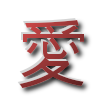Haiga is haiku painting. Hai refers to the poem or haiku and ga means painting. The form originated in seventeenth-century Japan and was used to decorate scrolls, albums, screens, and fans. You always find three elements in haiga: an ink-brush or watercolor painting, a poem or poems, and calligraphy. The form is characterized by a fresh and spontaneous rendering of ordinary, everyday life--very much in the haiku spirit--as well as by simple subjects, loose and fluid brushstrokes, and plenty of white space. It is usually very sketch-like with spare images expressed with just a few lines, little detail, and one or two colors for added visual interest.
In the second volume of A History of Haiku (Hokuseido Press, 1964), R. H. Blyth describes haiga as "the art of imperfection" and says that "Haiga omits what God should have omitted." He explains that "simplicity" [in haiga] has a meaning only in relation to complexity, and haiga does not suggest much with little, but rather emphasizes what is (poetically) important, what is overlooked by the ordinary (unpoetical) view of the object."
This aesthetic is very appealing to both amateur and professional poet-painters, and haiga continues to be created in Japan today . . .even in the face of the growing influence of Western modern art. Many enthusiasts share their haiga at meetings of the prominent All Japan Sekiho Haiga Association and study with such modern masters as Sekiho Yabumoto, Isshū Hattori, Makoto Kihara, and Seigyō Nasu. The largest publisher of haiga in Japan is the Shūsakusha Publishing Company, which produces a haiga magazine called the Quarterly Haiga Saijiki. The company also produces a number of books on how to create haiga. Increasingly, the Japanese are publishing and selling their haiga on the Internet. The Web sites, naturally, are usually in Japanese rather than in English.
Reprinted from Berries and Cream: Contemporary Haiga in North America, An Interview with Jeanne Emrich by Michael Dylan Welch. Foster City, California: Press Here, 2000.


